
- •Dry Cast Concrete
- •Wet Cast Concrete
- •Self-Compacting Concrete (SCC)
- •Sandwich Panel Construction
- •Precast Light Concrete
- •Precast Ultra Concrete
- •Types of Surface Finishes
- •Support and Fixings
- •Cost and Construction Matters
- •Glass Fibre Reinforced Concrete
- •Compact Reinforced Composite
- •Useful Contacts
- •Illustration Credits

Glass Fibre Reinforced Concrete
S T A D T V I L L A A PA R T M E N T S , K A S S E L
Alexander Reichel Architekten
Location
The city on the River Fulda, located in the heart of Germany offers fast and easy access by train and motorway. The building is located in Unterneustadt, a new urban area of Kassel.
Architectural Statement
The modular principle of this town house is based on the brief for an architectural competition. The task was to design a building type for the eight different plots of this residential development on the outskirts of Kassel’s Unterneustadt. Starting with a column grid of about 3m by 3.3m, this town house can be extended or modified to suit different uses and topographical conditions. One prototype was built as a straightforward cube measuring 13.52m by 12.3m by 15.4m; the other seven town houses were the responsibility of other prize winners. The building is set amid idyllic park-like surroundings not far from the River Fulda with its boat moorings and historic suspension bridge.
The use of full-height glazing to the living rooms allows the occupants to enjoy a view over the pleasant surroundings. The structure and the solid sections of the external walls are clad with glass fibre reinforced concrete panels; this artifice helps to indicate the different internal uses. The reinforced concrete frame members sometimes are clad in untreated larch wood infill panels. To emphasise the character of a detached villa, ancillary parking spaces are accommodated
within the building itself by means of a mechanical car stacking system. A
Corner view
maisonette with a floor area of 120m2 plus a low-level yard occupy the semibasement and ground floor. The space can be used as an office or an apartment. The accommodation above can be divided to create two or three room apartments (plus kitchens and bathrooms). The top two floors are again maisonettes, and have a generous rooftop patio overlooking the river.
In order to achieve the desired variety in the façade and the necessary structural clarity, the building was divided into various systems; the load-bearing construction of reinforced concrete frame with precast concrete floors planks and walls, the timber framing elements and the cladding to the structural members. These individual systems are designed to remain visible in the façade and hence they organize the building’s appearance. However, leaving a concrete structure exposed in Germany creates a building science problem. Owing to its high thermal conductivity, concrete must be insulated to prevent energy losses and damage caused by moisture. The concrete load-bearing structure was therefore clad with insulated precast elements. Glass fibre reinforced concrete (GRC) units just 30mm thick were chosen. In addition to their slim design and low weight, they are also easy to erect. The material and pattern of the joints of these accurate panels convey the structural rhythm of the concrete frame to the observer. GRC can be used as permanent formwork, as textured formwork or for rebuilding reliefs and cornices on older buildings, but here it is a façade panel. It consists of a fine aggregate concrete – the aggregate size is not more than 4mm – to which is added alkali-resistant glass fibre strands. These act as tension and anti-crack reinforcement. Each precast component is coated with a hydrophobic fluid at the works to produce a consistent, water repellent outer surface. This gives the surface a ‘milky’ shade which lends the material a vibrant quality.
The GRC panels were made by hand spraying both the concrete mix and the chopped fibres on to moulds. The unreinforced face mix of 5mm was colour matched to the grey concrete colour of the frame. This was coated with the reinforced backing mix that contained the chopped fibres whose length varied from 6-25mm and which were added at a dosage of 2% of the concrete volume. The backing mix was applied in five layers each of 5mm and compacted by rolling to bull up the panel thickness of 30mm.
P R O J E C T D AT A
Architect: Alexander Reichel
Structural Engineer: Hoben, Kleinhans, Marx
Main Contractor: Hochtief AG
Completion: 1999
146
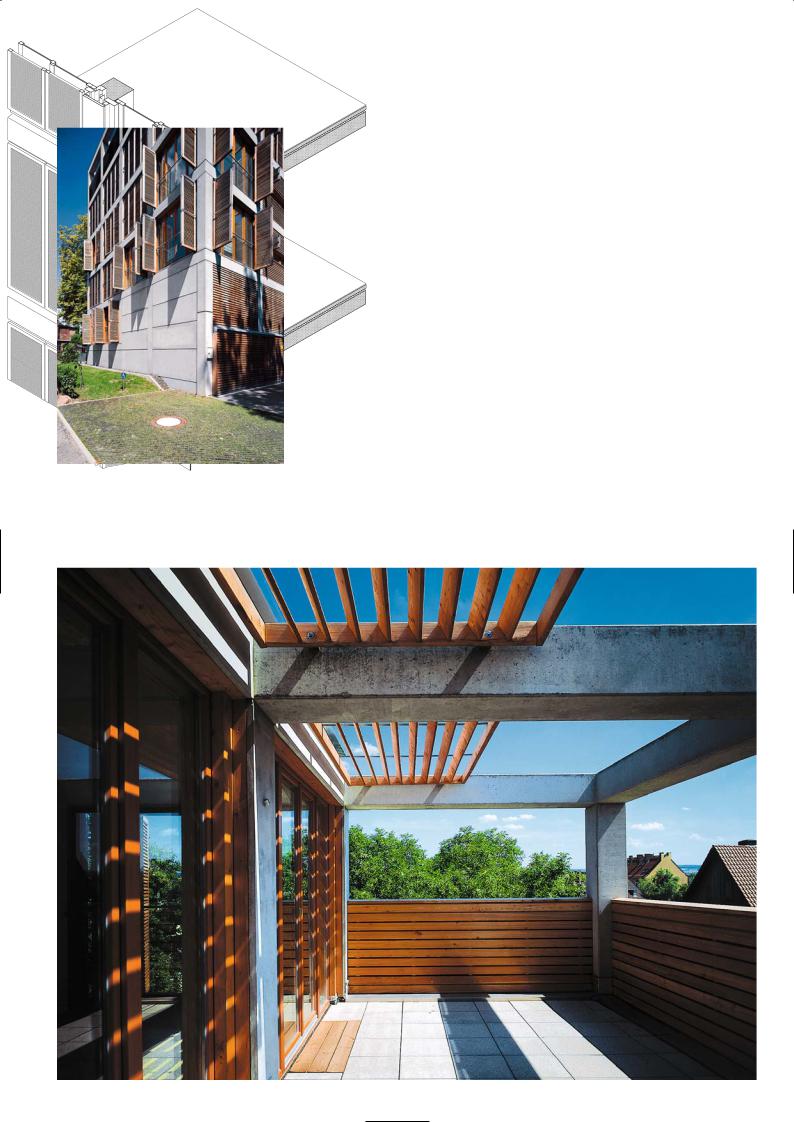
GRC panels and wooden shuttered windows |
Schematic façade detail |
showing GRC panel covering
structural concrete frame
Top floor terrace
147
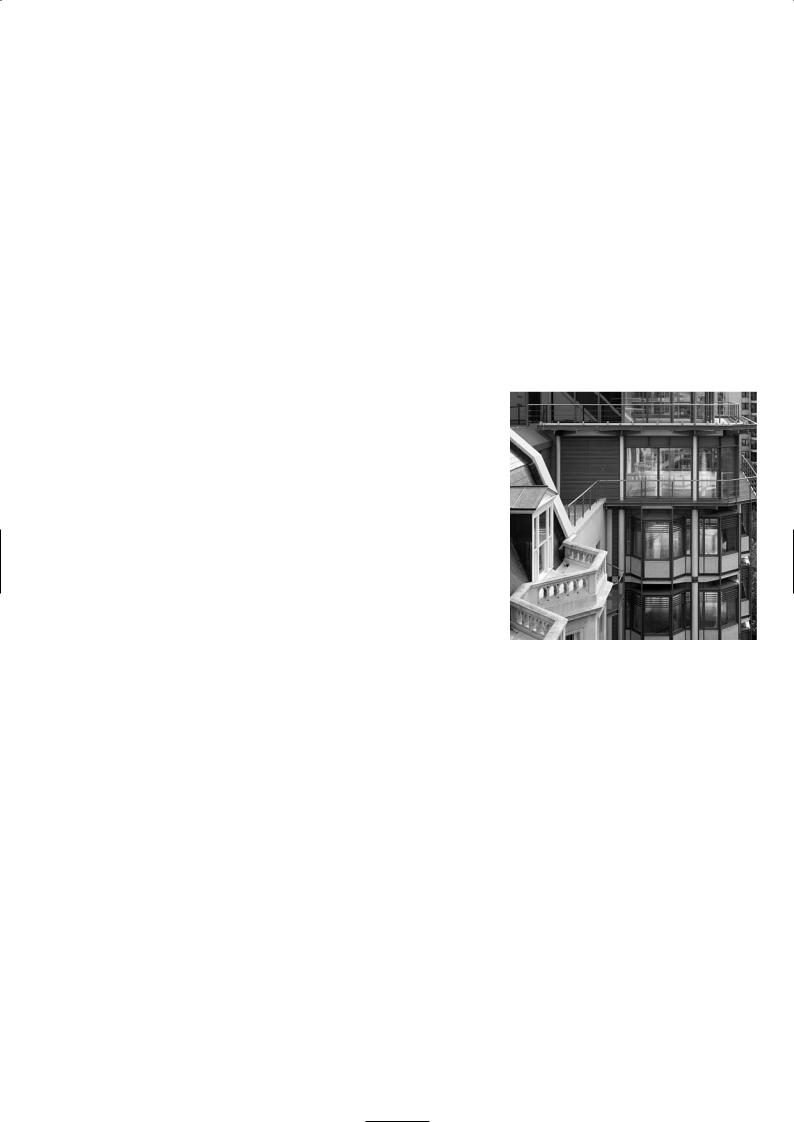
Glass Fibre Reinforced Concrete
2 5 - 3 5 PA R K L A N E , L O N D O N
Rolfe Judd Architecture
Location
The building is next door to the Hilton Hotel on Park Lane and Curzon Street and a short but pleasant walk from Hyde Park Corner tube station on the Piccadilly Line, in the West End of London.
Architectural Statement
The office development is formed around a newly landscaped square creating an attractive public open space and a tranquil approach to the main entrance from Curzon Street. This landmark building is made up of two new six-storey wings on either side of a five-storey listed building that has been fully modernised and refurbished. Built to a conceptual design by Michael Hopkins that has been reinterpreted and detailed by Rolfe Judd Architecture, the building offers 7,615m2 of prestigious office accommodation with unrivalled views of Hyde Park.
With the flexibility of entrances from Park Lane or Curzon Street, the three blocks that comprise the development have basement car parking, lower ground and ground floor and six upper floors. It has been designed to meet the needs of modern day business, with air conditioned column free spaces throughout and interior finishes of very high quality.
The envelope is an aluminium framing system supporting Portland stone ashlar spandrels, double glazed bay windows, lightweight GRC column pilasters and GRC ‘bird’s mouth’ reveals below the bay windows. Stainless steel brackets support the non-structural aluminium wind posts than run up the corners of the bay windows. At floor levels 5 and 6 there are brise soleils that overhang the façade and form a continuous balcony with a guard rail.
The structure is a reinforced concrete frame from basement to ground floor level and a steel frame with perforated steel beams and composite metal decking above it. The sixth floor steps back from the building line to accommodate the window cleaning track.
The cores for lift, stairwell and services are braced steel frames.
The receptions areas have green sandstone floors with feature up lighters and natural limestone walls with laminated etched glass partition walls. The doors are Canadian maple, the skirting is stainless steel and the suspended ceiling
smooth white plaster.
Existing building and new wing
Architectural Discussion
Graham Fairley
Our brief was to work to the original concept by Michael Hopkins as they had planning approval for a generous office development, and revise the way the details worked so that the build cost would not exceed 17 million GBP. In essence we had to halve the façade cost without changing its appearance. The Portland stone, the precast and the cast aluminium had to remain but instead of designing the assembly as loadbearing with solid precast elements we designed the elevation as cladding, as a skin that was structurally redundant. The façade thus became much easier to build and faster to erect. Now we could build the structure and bolt on the cladding afterwards.
One of our first ideas was to make the solid precast column from lightweight GRC column shells which drastically cut down the deadweight while retaining the monumental appearance. Although we did not know much about GRC at the time, our later researches into the product and discussions with Trent Concrete and Techcrete, made it seem the obvious choice. The bay window trims and pilaster columns were designed as 20mm thick GRC units which would fit onto the curtain wall frame and be erected by the curtain wall contractor. The storey-high cladding units with the feature bay windows were designed as pods with a metal floor and steel edge beams that bolted to the structural floor. It had an aluminium roof with an aluminium steel trim that connected to the floor above. The glazing, the GRC spandrel and pilaster columns units and the flat Portland ashlar all had to be fitted to the cladding frame. The cladding package under the construction management contract was sent to a number of specialist curtain wall companies which Plus Wall won. As Techcrete were not interested in bidding for the GRC work it was tendered by BMS and Trent. GRC is a good architectural product with a fine surface finish but it is trivialised as a fanciful cheap product suitable for bird baths, Corinthian columns, hideous statues, Greek urns and artificial rock.
Trent won the GRC supply contract. We resolved the supply and installation of the cladding elements by having Plus Wall erect the whole system and Trent deliver the units for Plus Wall to fit on site. One of the spandrel moulds for the bay window feature was made slightly too large and we had problems of fit
148
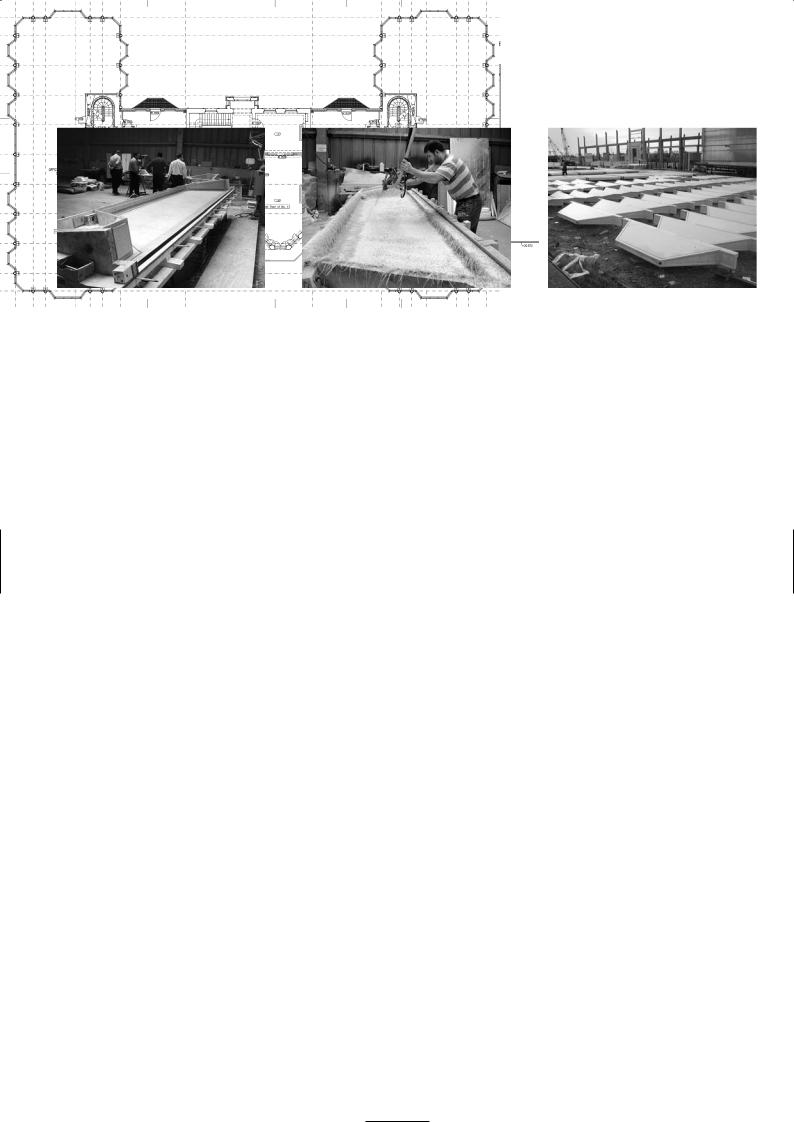
Mould |
Spraying GRC |
GRC ‘bird’s mouth’ reveals |
Park Lane elevation
First floor plan
149
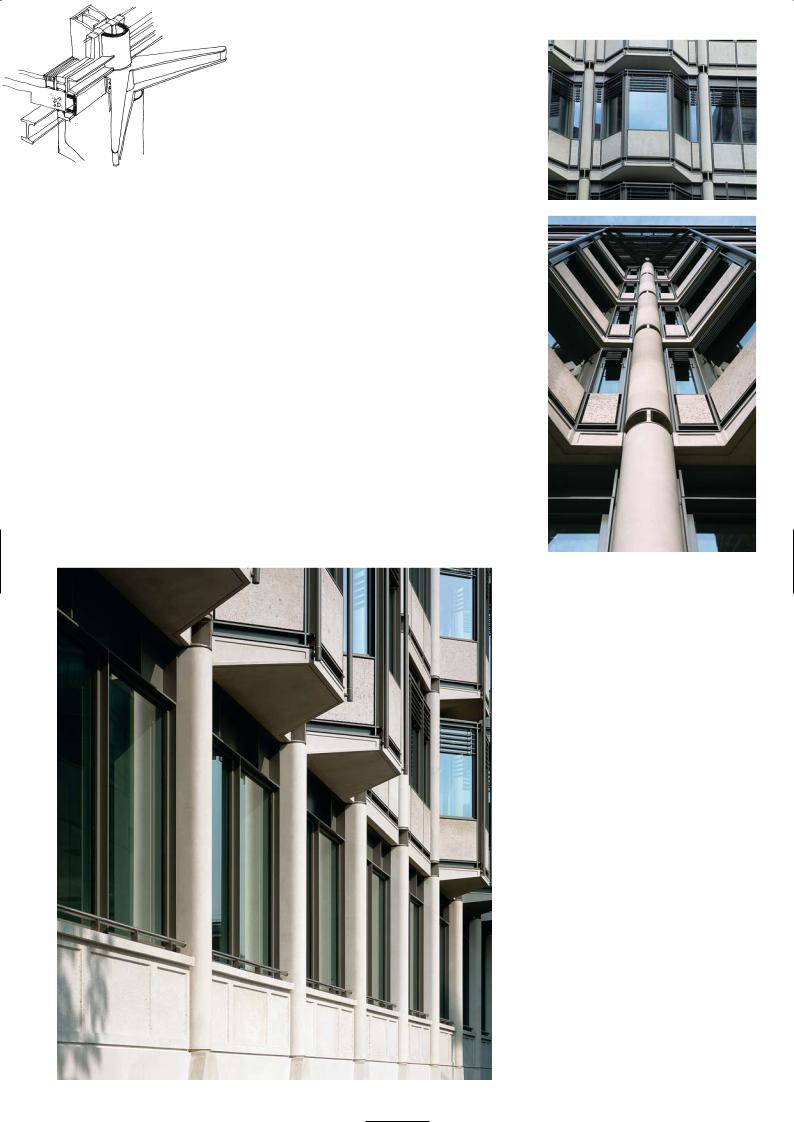
with the stainless steel node connections. There should have been a 20mm gap, instead the panel was 50mm too long. In the end Trent cut the end offs and repaired them. The mastic joint on one side of the panel was more than the other if you knew where to look. There was some crazing on the surface and a few arrises were not sharp.
The GRC finish and colour matched the Portland 'Grove Whitbed' ashlar supplied by Albion Stone and in many ways it was superior. We detailed the fascias to ensure that water was dispersed away from the panels and ashlar to minimise dirt staining. Where we have rain running on to the GRC spandrel panel from the glazing above it, we have sloped the panels inwards from top to bottom and introduced a small drip detail. There is metal backing to the panel which is the effective water barrier and protection to the insulation. I always remember studying buildings that Lutyens designed and noticing the way he sloped the stonework to reduce water marks and dirt staining.
GRC Construction
David Walker, Trent Concrete
We worked closely with the architects and the façade engineer to detail the fixing arrangement and check the panel integrity for movement and rigidity.
The panels were sprayed into ply mould lined with GRP. First the facing mix coat of 4mm colour matched to the Portland Stone sample was sprayed on. Then the backing coat with the alkali resistant glass fibre strands was sprayed again in 4mm layers and rolled for compaction, to build up the 16mm backing thickness. The surface was given an acid-etched finish and then supplied to Plus Wall on site to install them under our supervision.
Bay windows keep rainwater away from GRC |
The GRC pilasters and bay window reveals combine |
|
|
|
with flat ashlar panels |
Detail of cladding joint
P R O J E C T D AT A
Architect: Rolfe Judd Architecture
Structural and Services Engineer: Buro Happold
Façade Engineer: Arup Façades
Development Manager: Taylor Warren Developments
Construction Manager: Heery International
Curtain Walls: Plus Wall
GRC Manufacturer: Trent Concrete Ltd
Completion: 2002
Contract Duration: 2 years
150
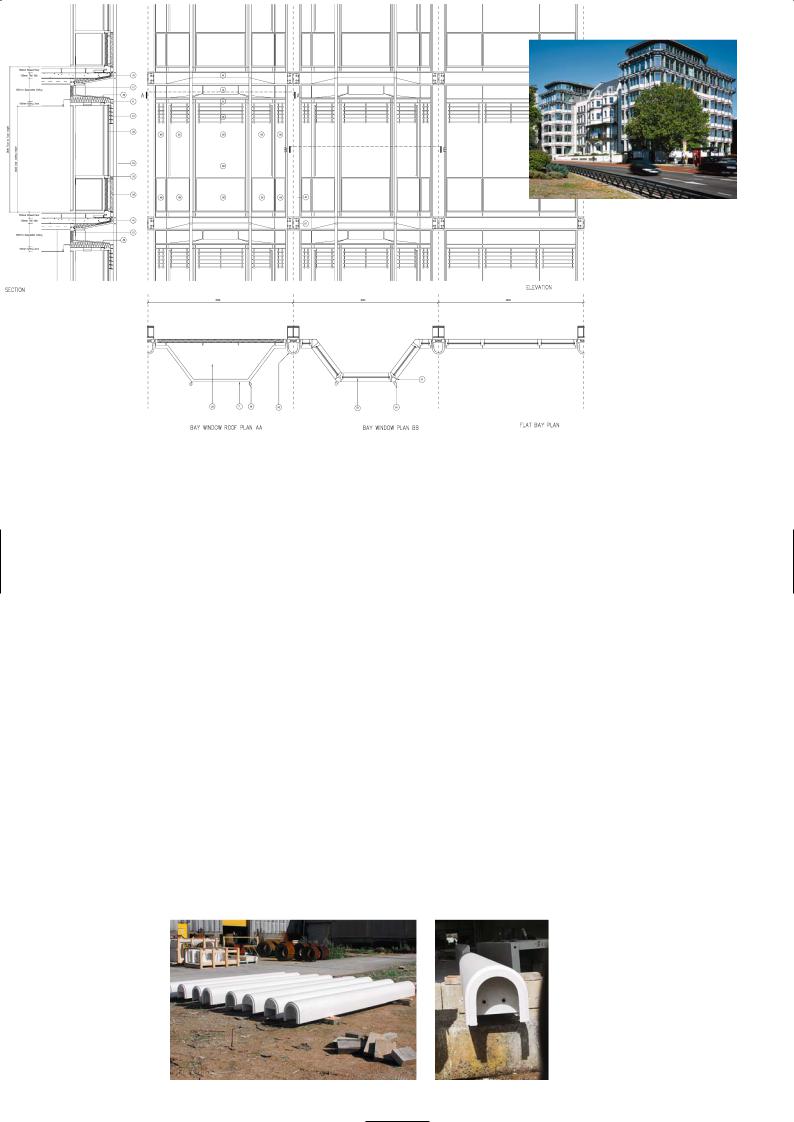
Park Lane elevation
Bay window detail: section, elevation and plan
Cantilever overhang of bay
window at floor level
GRC pilaster columns
151
